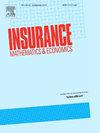预测和回溯测试预期短缺的梯度分配
IF 2.2
2区 经济学
Q2 ECONOMICS
引用次数: 0
摘要
资本配置是一个量化每个风险来源对总风险的贡献的过程。梯度分配规则,也称为欧拉原理,是一种普遍的资本分配规则,根据该规则,分配的资本将边际风险的多样化收益作为整体风险的组成部分。本文主要讨论了预期不足(ES)作为监管标准,以及ES的梯度分配,也称为ES贡献(ESCs)。本文基于联合可识别性和多目标可引性的概念,在传统回溯测试和比较回溯测试的框架下,对ESCs元组进行了全面的回溯测试。为了对评分函数的选择进行稳健的预测评价,我们还将墨菲图扩展到esc的情况下,墨菲图是一个图形工具,用于检查一类评分函数下一个预测是否优于另一个预测。最后,利用最近的多目标可选性概念,我们提出了一种基于组合回归模型的半参数预测动态ESCs模型。在股票收益的实证分析中,我们评估和比较了各种预测动态ESCs的模型,并证明了所提出模型的可靠性能。本文章由计算机程序翻译,如有差异,请以英文原文为准。
Forecasting and backtesting gradient allocations of expected shortfall
Capital allocation is a procedure for quantifying the contribution of each source of risk to aggregated risk. The gradient allocation rule, also known as the Euler principle, is a prevalent rule of capital allocation under which the allocated capital captures the diversification benefit of the marginal risk as a component of the overall risk. This paper concentrates on Expected Shortfall (ES) as a regulatory standard and focuses on the gradient allocations of ES, also called ES contributions (ESCs). We present the comprehensive treatment of backtesting the tuple of ESCs in the framework of the traditional and comparative backtests based on the concepts of joint identifiability and multi-objective elicitability. For robust forecast evaluation against the choice of scoring function, we also extend the Murphy diagram, a graphical tool to check whether one forecast dominates another under a class of scoring functions, to the case of ESCs. Finally, leveraging the recent concept of multi-objective elicitability, we propose a novel semiparametric model for forecasting dynamic ESCs based on a compositional regression model. In an empirical analysis of stock returns we evaluate and compare a variety of models for forecasting dynamic ESCs and demonstrate the solid performance of the proposed model.
求助全文
通过发布文献求助,成功后即可免费获取论文全文。
去求助
来源期刊

Insurance Mathematics & Economics
管理科学-数学跨学科应用
CiteScore
3.40
自引率
15.80%
发文量
90
审稿时长
17.3 weeks
期刊介绍:
Insurance: Mathematics and Economics publishes leading research spanning all fields of actuarial science research. It appears six times per year and is the largest journal in actuarial science research around the world.
Insurance: Mathematics and Economics is an international academic journal that aims to strengthen the communication between individuals and groups who develop and apply research results in actuarial science. The journal feels a particular obligation to facilitate closer cooperation between those who conduct research in insurance mathematics and quantitative insurance economics, and practicing actuaries who are interested in the implementation of the results. To this purpose, Insurance: Mathematics and Economics publishes high-quality articles of broad international interest, concerned with either the theory of insurance mathematics and quantitative insurance economics or the inventive application of it, including empirical or experimental results. Articles that combine several of these aspects are particularly considered.
 求助内容:
求助内容: 应助结果提醒方式:
应助结果提醒方式:


